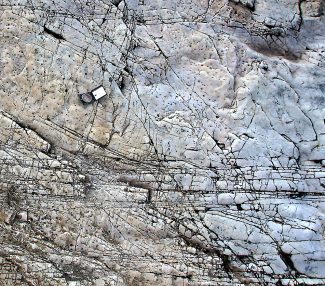A review of the role of chemistry in fracture pattern development and of prospects for future research was recently published in Reviews of Geophysics.
As a prestigious review publication by invitation only, Reviews of Geophysics provides a comprehensive overview of geophysics research.

Fracture pattern
Fracture pattern development has been a challenging area of research in the earth sciences for more than 100 years. Much has been learned about the spatial and temporal complexity inherent to these systems but severe challenges remain. The article in Reviews of Geophysics describes how future advances will require new approaches based on a chemical perspective.
Chemical processes play a larger role in opening-mode fracture pattern development than has hitherto been appreciated. A chemical perspective helps solve challenges to understanding subsurface fractures, including how to better use limited subsurface samples, how to interpret ambiguous outcrop analogs, and how to overcome difficulties determining which models are correct from observations.
The paper describes how many tools of chemical analysis, experiment, modeling and theory can be brought to bear on understanding how fracture patterns develop at geological time scales. A major conclusion is that chemical and mechanical investigations together have great potential to solve challenging practical problems in subsurface science.
The theme of chemical-mechanical interaction has been central to the Structural Diagenesis Initiative since the outset.
Four current (Fall 2019) Ph.D. projects are investigating aspects of the role of chemistry in fracture pattern development.
The AGU editors blog features a short article that underscores some of the highlights of the Reviews of Geophysics paper.
The Reviews of Geophysics paper can be found here:
- Laubach, S.E., Lander, R.H., Criscenti, L.J., et al., 2019. The role of chemistry in fracture pattern development and opportunities to advance interpretations of geological materials. Reviews of Geophysics, 57 (3), 1065-1111. doi:10.1029/2019RG000671 | view | AGU editor’s Vox | JSG press release
The highlights article in AGU Editor’s Vox can be found here:
Laubach, S. E. 2019. How chemical processes influence fracture pattern development. EOS, 100, doi:10.1029/2019EO136309 (American Geophysical Union) | view Editor’s Vox
And a press release from the Jackson School of Geosciences about the Reviews of Geophysics paper can be found here:
Jackson’s School press release, November 2019
Related work
Three papers closely related to the theme of chemistry in pattern development:
Laubach, S.E, P. Eichhubl, C. Hilgers, R.H. Lander, 2010, Structural diagenesis. Journal of Structural Geology 32 (12), 1866-1872. doi:10.1016/j.jsg.2010.10.001. | view
Lander R.H., and Laubach, S.E., 2015. Insights into rates of fracture growth and sealing from a model for quartz cementation in fractured sandstones. Geological Society of America Bulletin 127 (3-4), 516-538. doi: 10.1130/B31092.1 | view
Laubach, S.E., Lamarche, J., Gauthier, B.D.M., Dunne, W.M., and Sanderson, D.J., 2018. Spatial arrangement of faults and opening-mode fractures. Journal of Structural Geology 108, 2-15. doi.org.10.1016/j.jsg.2017.08.008 | view
Practical aspects
And two initiative papers published in the Fall 2019 highlight the practical benefits of using a chemical perspective to inform fracture analysis:
Weisenberger, T., Eichhubl, P., Laubach, S.E., and Fall, A., 2019. Degradation of fracture porosity by carbonate cement, Piceance basin, Colorado, USA. Petroleum Geoscience, 25, 354-370. doi:10.1144/petgeo2018-162 | view | blog post
Almansour, A., Laubach, S.E., Bickel, J.E., and Schultz, R.A., 2019. Value of Information analysis of a fracture prediction method. SPE Reservoir Evaluation & Engineering, doi: 10.2118/198906-PA | view | blog post
© 2024 Jackson School of Geosciences, The University of Texas at Austin


